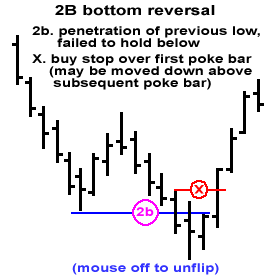BSD
Veteren member
- Messages
- 3,819
- Likes
- 988
As I said earlier, except for the catastrophe stop, used in the event of a power disruption or the loss of the connection to the broker or a sudden, temporarily incapacitating mini-stroke, stops are nothing more than training wheels, used by those who aren't yet confident in what they're doing. These individuals place the trade, set the stop, then sit back hopeful (or fearful, as the case may be) and hand over all responsibility for the trade to the stop. If and when they are stopped out, they state (or wail) that they were "stopped out", as though they themselves had nothing to do with the outcome of events.
Stops are essential to those who are not yet able to trade unemotionally, which, from what I read, is just about everybody. But those who can continue whatever assessment of conditions that they began before placing the trade throughout and after the entry will find little use for stops. If the trade is wrong, for whatever reason, they're out, and they continue their assessment of trading conditions without interruption, looking for the next opportunity.
DB, you're a good guy, but, to be honest, I think that's total nonsense.
Pretty much all of the Market Wizards agree with my assessment, but nobody made the point more succinctly than Bruce Kovner, who is a Billionaire these days running Caxton Associates, his Billion dollar hedge fund:
"- Bruce Kovner
Michael Marcus taught me one other thing that is absolutely critical: You have to be willing to make mistakes regularly; there is nothing wrong with it. Michael taught me about making your best judgment, being wrong, making your next best judgment, being wrong, making your third best judgment, and then doubling your money.
Whenever I enter a position, I have a predetermined stop. That is the only way I can sleep. I know where I'm getting out before I get in. The position size on a trade is determined by the stop, and the stop is determined on a technical basis. I never think about other people who may be using the same stop, because the market shouldn't go there if I am right.
Place your stops at a point that, if reached, will reasonably indicate that the trade is wrong, not at a point determined primarily by the maximum dollar amount you are willing to lose.
If you personalize losses, you can't trade."
Mechanical Trading Systems - Expert Citations
Eg when I am trading a double top that's what I trade, and that's it.
If it turns into a triple top I can reenter, but I still have one loser.
What's the big deal.

